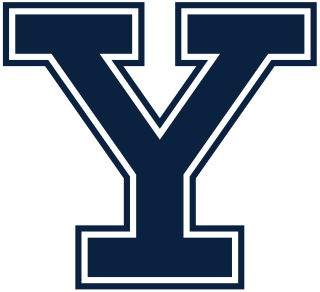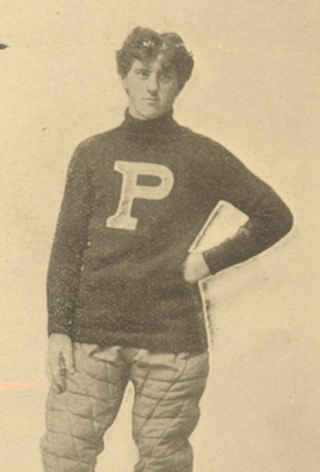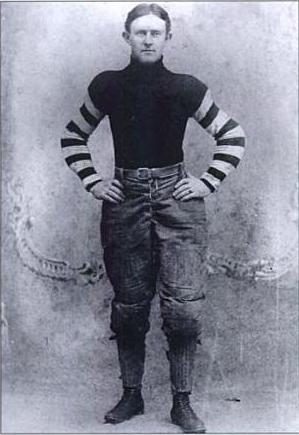
The Harvard Crimson is the nickname of the intercollegiate athletic teams of Harvard College. The school's teams compete in NCAA Division I. As of 2013, there were 42 Division I intercollegiate varsity sports teams for women and men at Harvard, more than at any other NCAA Division I college in the country. Like the other Ivy League colleges, Harvard does not offer athletic scholarships.

The Yale Bulldogs are the intercollegiate athletic teams that represent Yale University, located in New Haven, Connecticut. The school sponsors 35 varsity sports. The school has won two NCAA national championships in women's fencing, four in men's swimming and diving, 21 in men's golf, one in men's hockey, one in men's lacrosse, and 16 in sailing.

Charles Ramsay Rinehart was an American football player, engineer and businessman. He was elected to the College Football Hall of Fame in 1964. He played high school football at Phillipsburg High School in Phillipsburg, New Jersey.
Alfred E. Bull was an American football player, coach and rower. He played football at the University of Pennsylvania and was selected as a center to the 1895 College Football All-America Team. Bull later served as the head football coach at the University of Iowa (1896), Franklin & Marshall College (1896–1897), Georgetown University (1900), Lafayette College (1903–1907), and Muhlenberg College (1908–1910), compiling a career college football coaching record of 62–34–15.

Otman Franklin "Otto" Wagonhurst was an American football player and coach. Wagonhurst played college football as a left tackle at the University of Pennsylvania from 1892 to 1895. He served as the head football coach at the University of Alabama in 1896 and at the University of Iowa in 1897, compiling a career record of 6–5. After coaching college football, he played professionally for Pittsburgh's Duquesne Country and Athletic Club and the Homestead Library and Athletic Club. He won circuit championship titles with Duquesne in 1898 and 1899 and Homestead in 1900. After his football career, he went on to become a railway executive. He died in 1932 in Jackson, Michigan and was buried in Akron, Ohio.

William Charles Wurtenburg was an American college football player and coach. Born and raised in Western New York to German parents, Wurtenburg attended the prestigious Phillips Exeter Academy, where he played football. He enrolled in classes at Yale University in 1886 and soon earned a spot on the school's football team. He played for Yale from 1886 through 1889, and again in 1891; two of those teams were later recognized as national champions. His 35-yard run in a close game in 1887 against rival Harvard earned him some fame. Wurtenburg received his medical degree from Yale's Sheffield Scientific School in 1893.

Matthew Henry McClung Jr., sometimes referred to as Dibby McClung, was an American college football player, coach and official. Born into a powerful southern family, McClung was raised in Memphis, Tennessee until he was accepted into Lehigh University. Immediately establishing himself as a skilled sportsman, McClung participated on both the school's football and baseball teams. He served as captain of the former in 1892 and is credited with turning it into one of the school's best ever football squads. McClung graduated from Lehigh in 1893 with degrees in metallurgy and mining engineering.
The Latrobe Athletic Association was a professional football team located in Latrobe, Pennsylvania, from 1895 until 1909. A member of the unofficial Western Pennsylvania Professional Football Circuit, the team is best known for being the first football club to play a full season while composed entirely of professional players. In 1895, team's quarterback, John Brallier, also became the first football player to openly turn professional, by accepting $10 and expenses to play for Latrobe against the Jeannette Athletic Club.
The Greensburg Athletic Association was an early organized football team, based in Greensburg, Pennsylvania, that played in the unofficial Western Pennsylvania Professional Football Circuit from 1890 until 1900. At times referred to as the Greensburg Athletic Club, the team began as an amateur football club in 1890 and was composed primarily of locals before several professional players were added for the 1895 season. In 1894 it was discovered that the team had secretly paid formerly Indiana Normal player, Lawson Fiscus, to play football and retained his services on salary. The team was the chief rival of another early professional football team, the Latrobe Athletic Association.
The Duquesne Country and Athletic Club was a professional football team based in Pittsburgh, Pennsylvania from 1895 until 1900. The team was considered one of the best, if not the best, professional football teams in the country from 1898 until 1900. However, the team is most famous for being the first football franchise to be owned by an individual, William Chase Temple.

The 1900 Homestead Library & Athletic Club football team won the professional football championship of 1900. The team was affiliated with the Homestead Library & Athletic Club in Homestead, Pennsylvania, near Pittsburgh. The team featured a lineup of former college All-Americans paid by Pittsburgh Pirates' minority-owner William Chase Temple.

William Wells Church was an American football player and coach. A native of Chicago, he played college football at Princeton University, where he was selected as an All-American at tackle in 1896. He served as the head football coach at Purdue University for one season, in 1897, and at Georgetown University for two seasons, in 1899 and 1901, compiling a career college football record of 5–3–1. Church participated in early professional football: He played tackle for the Duquesne Country and Athletic Club in 1898 and the Homestead Library & Athletic Club in 1900, also coaching the latter team. He married Mary Myrtle Brock in 1902.

John Ashley "Daff" Gammons was an American baseball and football player, college football and baseball coach, amateur golfer, and insurance agent. He played professional baseball for one season, 1901, for the Boston Beaneaters. Gammons served as the head football coach at Brown University in 1902, 1908, and 1909, and as its head baseball coach from 1901 to 1903.
The Knickerbocker Athletic Club was an early amateur and later professional football team based in Manhattan, New York City from around 1897 until 1902. The team is best known for participating in the 1902 World Series of Football. During the event, the Knickerbockers defeated the Warslow Athletic Club from Long Island by a score of 11–6. However, the Knickerbockers were defeated by the Syracuse Athletic Club, 36–0, on New Year's Eve. During the 1903 World Series of Football, the Olympic Athletic Club defeated Knickerbockers 6–0, on December 14, 1903.

JohnMoore Van Cleve was an American football player and coach, and one of the first known professional players of the sport. After playing college football at Lehigh, he played five seasons for independent teams in or near Pittsburgh and served in 1898 as player-coach for Pittsburgh College, later known as Duquesne University.

James Joseph Hogan was an Irish-American college football player. A member of the Yale Bulldogs football team from 1901 to 1904, he was recognized three times as a consensus All-America selection. He was posthumously elected to the College Football Hall of Fame in 1954.
John C. Hedges was an American football player and coach of football and baseball. Hedges played college football at the University of Pennsylvania. He served as the head football coach at Ursinus College in 1899, compiling a record of 2–5–1. He started the 1900 season as head coach at Lebanon Valley College, but left after posting a record of 1–1 in the team's first two games. Later that season, he played professional football for the Duquesne Country and Athletic Club. He served as the head football coach at Franklin & Marshall College, located in Lancaster, Pennsylvania, for the 1901 season. His coaching record at Franklin & Marshall was 7–3–1. While at the school, he also held the title of "Physical Director" of the college.

Frank Hudson was a football player and coach who was a member of the Laguna Pueblo tribe from New Mexico.

Eugene Lawrence Messler was an American football player and coach and businessman. He played at the tackle position for Yale's 1891, 1892, and 1893 championship teams, coached the 1894 Centre football team, and played on the Duquesne Country and Athletic Club professional football teams from 1895 to 1897. He was the general superintendent of Jones and Laughlin Steel Company's Pittsburgh coke ovens and blast furnaces from approximately 1899 to 1911 and the president of the Eureka Fire Brick Company for many years commencing in 1907.

The 1899 Homestead Library & Athletic Club football team played professional football in 1899. The team was affiliated with the Homestead Library & Athletic Club in Homestead, Pennsylvania, near Pittsburgh.














